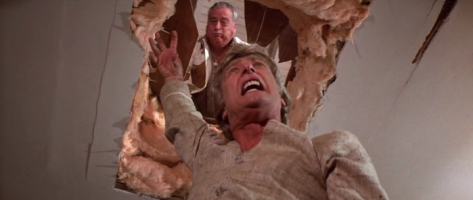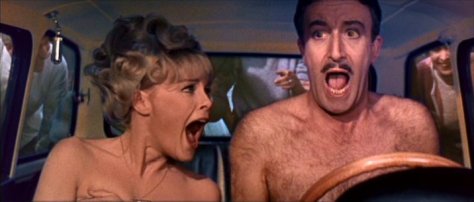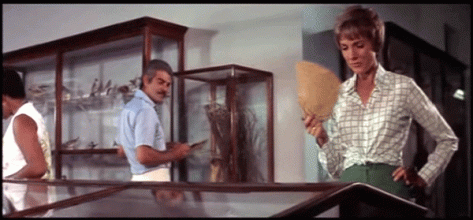By Dennis Hartley
(Originally posted on Digby’s Hullabaloo on December 18, 2010)

When I heard that director Blake Edwards had died earlier this week, at 88, I felt like I had lost an old friend. I grew up watching his films. He dabbled in many genres, and was proficient in all, but especially adept at comedy. He was one of a handful of filmmakers who could sell me on slapstick; he had a knack for choreographing sequences of pratfalls (executed with balletic precision) that became funnier and funnier the longer they ran on. He was a superb screenwriter as well. Here are my top ten picks from the Blake Edwards oeuvre (37 feature films from 1955-1995), alphabetically:

Breakfast at Tiffany’s-Edwards turned Truman Capote’s novel about a farm girl who moves to the Big Apple and reinvents herself as a Manhattan socialite into a damn near perfect film (Mickey Rooney’s unfortunate role as a racial stereotype aside). Audrey Hepburn and George Peppard (both at the peak of their attractiveness) are a stunning screen couple. A funny, sophisticated, and bittersweet story, wonderfully directed, acted, written (George Axelrod adapted) and set to a great Henry Mancini score (it wasn’t the first time Edwards collaborated with the composer, and certainly not the last-they worked together on close to 30 films over several decades).

Days of Wine and Roses-This shattering drama was jarring for its time (apparently prompting a rash of opening-week walkouts by Jack Lemmon fans expecting another comic role). The film still packs a wallop in its depiction of a couple (Lemmon and Lee Remick) and their descent into a co-dependent alcoholic hell. Lemmon and the frequently underrated Remick deliver their finest performances.
Everyone remembers the “greenhouse scene”, but for me the most memorable moment arrives in the “padded room” scene, with a sweating, screaming, strait-jacketed Lemmon writhing in withdrawal. Call it “method” or whatever, but it remains one of the top examples of an actor completely “in the moment” ever captured on film. Henry Mancini won an Oscar for the lovely theme song.

The Great Race– While this 1965 Edwards comedy-adventure about a turn-of-the-century New York to Paris auto race begins to overstay its welcome about 2/3 of the way through, after revisiting it recently, I have to say that the laughs have held up quite well. Clocking in at a whopping 160 minutes, it was released at a time when overblown, big-budgeted comedies with huge international casts were in vogue (especially in the wake of the mega-hit It’s a Mad Mad Mad Mad World in 1963). But what a cast-Jack Lemmon, Tony Curtis, Natalie Wood, Peter Falk and Keenan Wynn (to name a few).

The Party-Director Edwards and mercurial acting genius Peter Sellers paired up many times, but I think this 1968 gem is not only their best collaboration, but frame-for-frame, one of the all-time great screen comedies.
Sellers is Hrundi V. Bakshi, an Indian actor with a bit part in a Hollywood war epic who somehow manages to ruin an expensive day of shooting by (riotously) overplaying his death scene. The exasperated director calls for the actor’s head, and Bakshi’s name ends up on a studio exec’s hurriedly scribbled “to do” list. Through a comedy of errors, Bakshi’s name is instead added to a guest list for a party being organized by the executive’s wife. The bumbling (if well-meaning) Bakshi proceeds to make a riotous shambles of the event.
Sellers’ knack for physical comedy is right up there with the best of Chaplin and Keaton. A guitar-wielding Claudine Longet is also on board as the love interest, and purrs a jazzy number in one scene.

S.O.B.-Whereas The Party was a relatively benign poke at Tinseltown, this 1981 dramedy offers a more jaundiced view of the Hollywood machine, which has chewed up and spit out a producer (Richard Mulligan). He flips out after his latest film, a high-budget, G-rated musical starring his singer-actress wife (Julie Andrews) tanks with critics and flops at the box office. Desperate to salvage it, he comes up with an idea to buy the film back from the studio, and “sex it up” by convincing his wife to re-shoot her part, including nude scenes, which would turn her “wholesome” image on its head.
Edwards’ screenplay is supposedly laced with autobiographical touches (as you may well know, Edwards was married to a certain singer-actress…whose name rhymes with “Julie Andrews”). It’s Edwards’ most cynical film, but also quite funny. The great cast includes William Holden (sadly, his final role), Robert Vaughn, Robert Webber, Larry Hagman, Loretta Swit, and Shelly Winters. Robert Preston is priceless as a “Dr. Feelgood” MD. It’s worth the price of admission to hear a ‘luded-up Andrews utter her immortal line: “Oh…Hi, Polly! Come to see my boobies?”

A Shot in the Dark-This second outing in the “Pink Panther” series is my favorite entry. The fact that the lovely Elke Sommer is in this film has no bearing on my appraisal. I wanted to make that clear. Okay, maybe it has a little bearing. Sommer is Maria Gambrelli, the maid who might have “dunnit”. That is, shot her rich employer’s limo driver. Or did she? It’s up to Inspector Jacques Clouseau (Peter Sellers) to figure that out, as more victims start dropping like flies.
There are so many great gags and classic exchanges in this one, including a memorable sequence in a nudist colony. Herbert Lom (who had previously co-starred with Sellers in several classic Ealing Studios comedies) introduces the character of Chief Inspector Dreyfus, who would become a fixture in subsequent sequels.
I feel this is the best one of the series because it strikes a perfect middle ground between the first film (which actually played it more sophisticated and fairly straight, as did Sellers) and the later films, which, while quite entertaining, became more and more far-fetched and cartoon-like as the franchise found more box office success.

The Tamarind Seed-A largely forgotten, but absorbing and worthwhile Edwards film from 1974, this was his nod to cold war spy thrillers like From Russia With Love, The Spy Who Came in From the Cold, The Deadly Affair and Hitchcock’s Torn Curtain (the latter film which, interestingly, also featured Julie Andrews). Andrews co-stars here with Omar Sharif. She is a British civil servant, he is a Russian spy, and, well, you can guess what happens next. And yes, it does create “conflicts of interest” for the lovers, which makes for intrigue and suspense, with a sultry Caribbean backdrop. Edwards adapted the screenplay from the novel by Evelyn Anthony. Unfortunately, there is no Region 1 DVD release; perhaps there will be now?

10– Talk about a “perfect” storm-Blake Edwards’ writing and directing skills, Dudley Moore’s impeccable comic timing, and Bo Derek’s, erm, well…Bo Derek-ness. Moore is a 40-something L.A. songwriter with a devoted girlfriend (Julie Andrews) and a long time friend/songwriting partner (Robert Webber) who both dutifully warn him that they can see signs of a looming mid-life crisis. After spotting a beautiful young woman (Derek), he becomes obsessed with her. Temporarily insane with unrequited lust, he decides to follow her (and her boyfriend) to Mexico, where they are headed for a holiday. Much middle aged craziness (and hilarity) ensues.
Moore is so dead-on funny that you don’t really stop to consider that his character can be seen as a creepy stalker at times. The narrative does take an interesting about-face about 2/3 of the way through, turning into an introspective and melancholic morality tale. It is vastly entertaining, however, with excellent performances by all. Brian Dennehy is a standout as a philosophical bartender.

Victor/Victoria-A fluffy but entertaining rom-com starring (wait for it) Julie Andrews, who plays an underemployed, classically-trained soprano scraping by in 1930s Paris. She befriends another unemployed singer (Robert Preston), who was recently booted from his gig at a cabaret. He cooks up a scheme that he is convinced will get them both out of the poorhouse: He will be her manager, and she will pose as a “he”, who impersonates a “she” onstage. Get it? Genius! Are there complications? Of course there are-and that’s when the fun starts. James Garner and Lesley Ann Warren are wonderful. Henry Mancini is on board again with a great musical score. Triple-threat Andrews sings, acts and dances with her usual aplomb.

Wild Rovers-Blake Edwards made a western? Yes, he did, and not a half-bad one at that. A world-weary cowhand (William Holden) convinces a younger (and somewhat dim) co-worker (Ryan O’Neal) that since it’s obvious that they’ll never really get ahead in their present profession, they should give bank robbery a shot. They get away with it, but then find themselves on the run, oddly, not so much from the law, but from their former employer (Karl Malden), who is mightily offended that anyone who worked for him would do such a thing. Episodic and leisurely paced, but ambles along quite agreeably, thanks to the charms of the two leads, and the beautiful, expansive photography by Philip Lathrop. Ripe for rediscovery.
10 more to explore: Operation Petticoat, Experiment in Terror, The Pink Panther, What Did You Do in the War, Daddy?, The Carey Treatment, The Return of the Pink Panther, The Pink Panther Strikes Again, Micki + Maude, Blind Date, Switch.





























